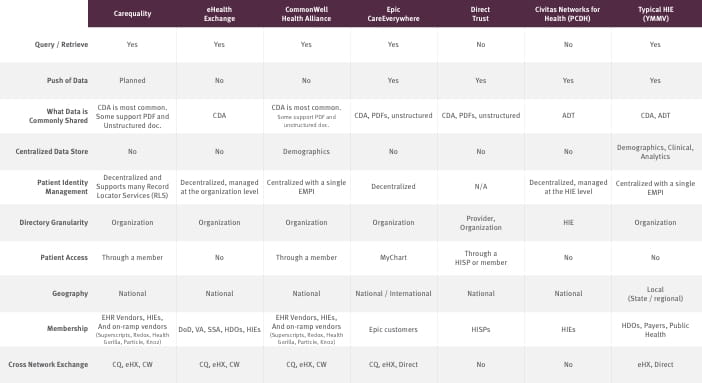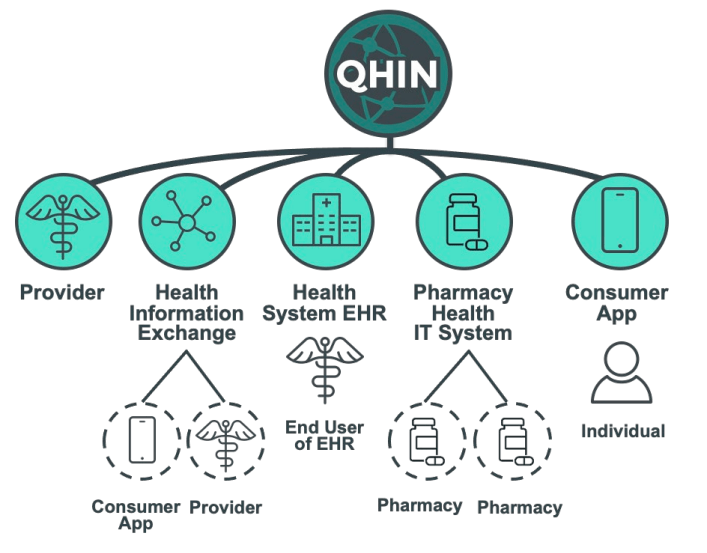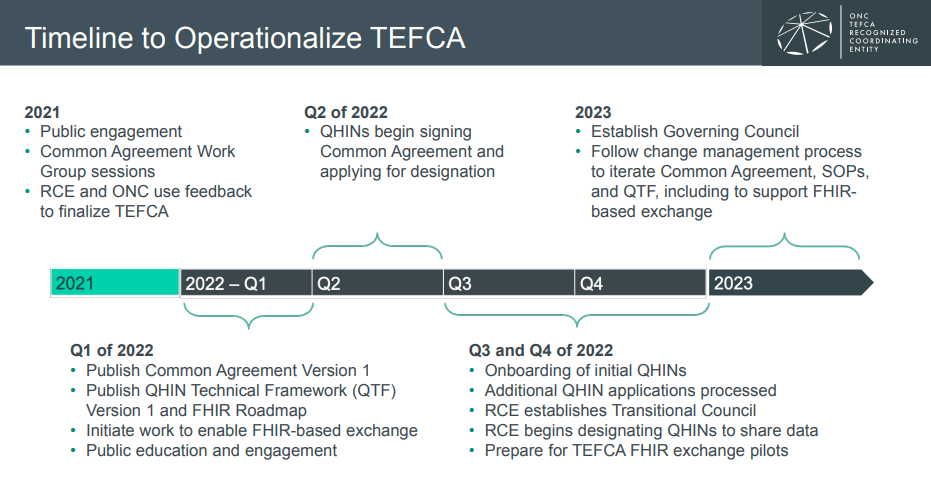This week, HHS and the ONC announced the publication of the Trusted Exchange Framework and Common Agreement (TEFCA). This milestone completes a critical requirement of the landmark 21st Century Cures Act, which called for establishing a national exchange framework to support data sharing between providers, health plans, patients, HIEs, and public health organizations.
TEFCA has three main goals:
- Establish a universal policy and technical floor for nationwide interoperability
- Simplify connectivity for organizations to exchange information
- Enable individuals to gather their healthcare information
If these goals sound like the goals of exchange networks that exist today, then it shows you’ve been paying attention! First, let’s talk about how data moves in healthcare in 2022.
Background
Organizations like Carequality, eHealth Exchange, Common Well Health Alliance, Direct Trust, Civitas Networks for Health, and state-designated HIEs all provide data sharing for their respective members and downstream participants—within the confines and capabilities of their separate domains.
There are a variety of exchange mechanisms, member profiles, content support, and patient access rules available from these organizations. Where Carequality allows providers to query and retrieve information from other members, Direct Trust enables data push. Some networks support centralized patient identity management (e.g., CommonWell and most HIEs), while others have decentralized solutions (e.g., eHealth Exchange, Carequality). Only a few support direct patient access.
What’s new with TEFCA is that we now have a set of technical standards (the exchange framework) and rules of the road (the common agreement) that will enable data sharing between these networks and their respective members, technology vendors, and patients.
How TEFCA works
It’s a “big tent” process with guidelines and guardrails defined by ONC (Office of the National Coordinator for Health Information Technology). After establishing the overall policies and network governance requirements, ONC then identified an organization to execute on that vision. They called this the “Recognized Coordinating Entity” (RCE), and after a public process, the Sequoia Project was chosen.
QHINs
TEFCA introduces the idea of a Qualified Health Information Network (QHIN) in support of a broad range of participants, providers, HIEs, EHRs, and consumer applications. Organizations and networks like those identified in the table above will likely apply to become QHINs—extending their reach to support broader use-cases and levels of access. Importantly, participation in a QHIN will universalize the membership agreement to enable cross-network access. These “flow-down provisions” will address topics of privacy, security, cooperation and nondiscrimination, confidentiality, and directory usage—all significant challenges for previous interoperability efforts.
What can providers and patients expect
As of this writing, TEFCA is optional, and there is no requirement for providers and organizations to participate. In 2022, a lot of groundwork will be completed to operationalize and authorize the QHINs. Now that TEFCA has been published, potential QHINs will begin reviewing the agreement and applying for designation.
In the future, TEFCA may become a requirement for participation in government programs (potentially Medicare/Medicaid funding). At that time, providers and patients can expect easier onboarding and complete data exchange between organizations
Example scenarios enabled by TEFCA
Patient Access: Using her phone, a patient downloads a health app registered with a QHIN. After verifying her identity, she can use her connected app to access her data from any interconnected system across the network. Using the app, she will access all of her data, not simply those on the same EHR her provider uses, the same HIE in her state, or even the same exchange network.
Public Health: A public health investigator performs a case investigation and has received the necessary authorizations to understand all previous care provided to a patient. The public health agency sends a request for medical records to QHIN A for the Exchange Purpose of Public Health. QHIN A can broadcast that query to other QHINs (B, C, D, etc.) who subsequently request records from their connected systems. All available systems can respond and return relevant documents to meet the public health request.
Government Benefits Determination: A patient applies for disability determination from the Social Security Administration. Using the patient’s authorization, the SSA requests medical records from QHIN A to complete a records review. QHIN A can broadcast the query to other QHINs, query their participants and retrieve the data to enable the SSA to meet the disability determination.
What are the next steps? Learn more about TEFCA by visiting the Sequoia Project’s resources page.
Thank you Brendan Keeler (@healthbjk) for the review of the national networks and their capabilities.








